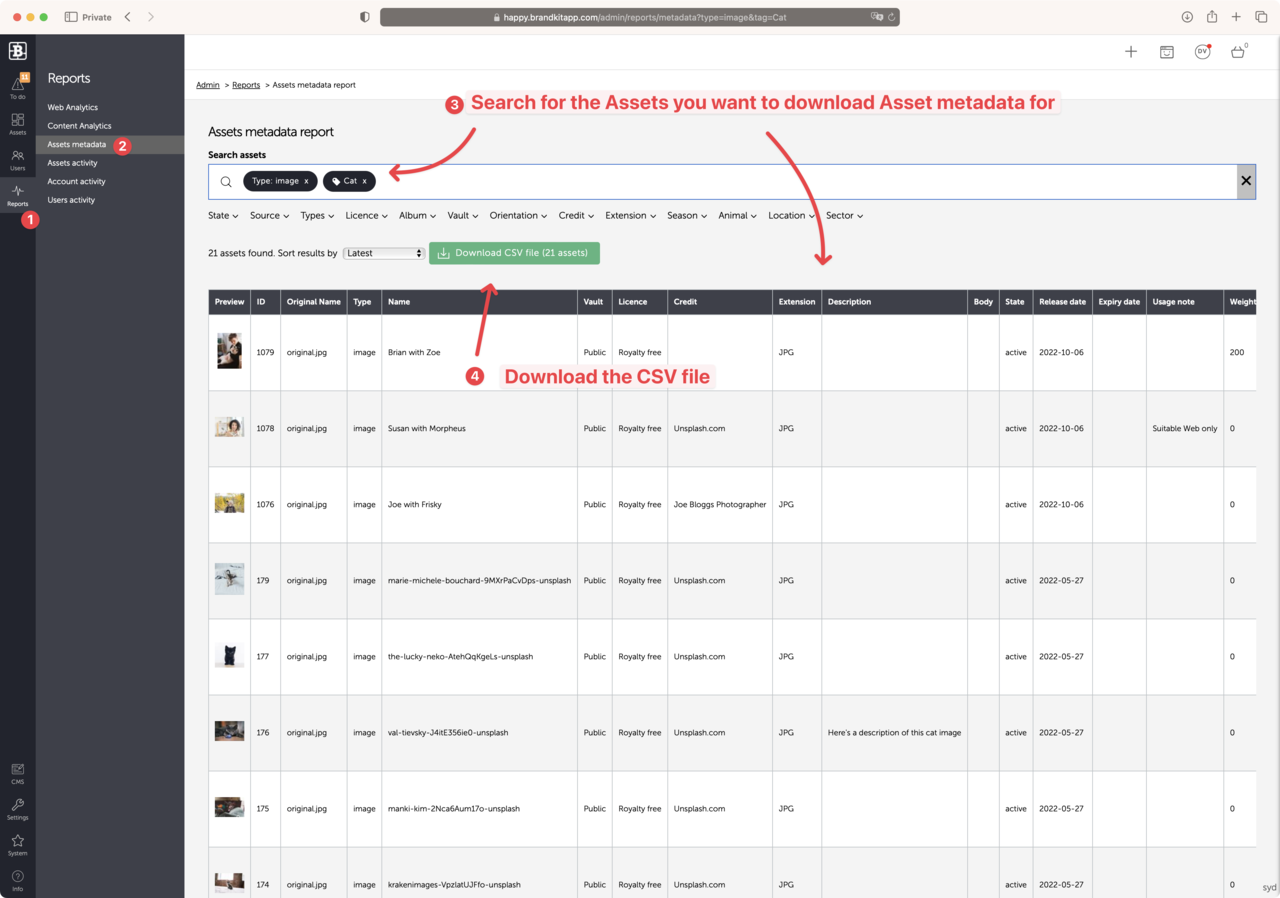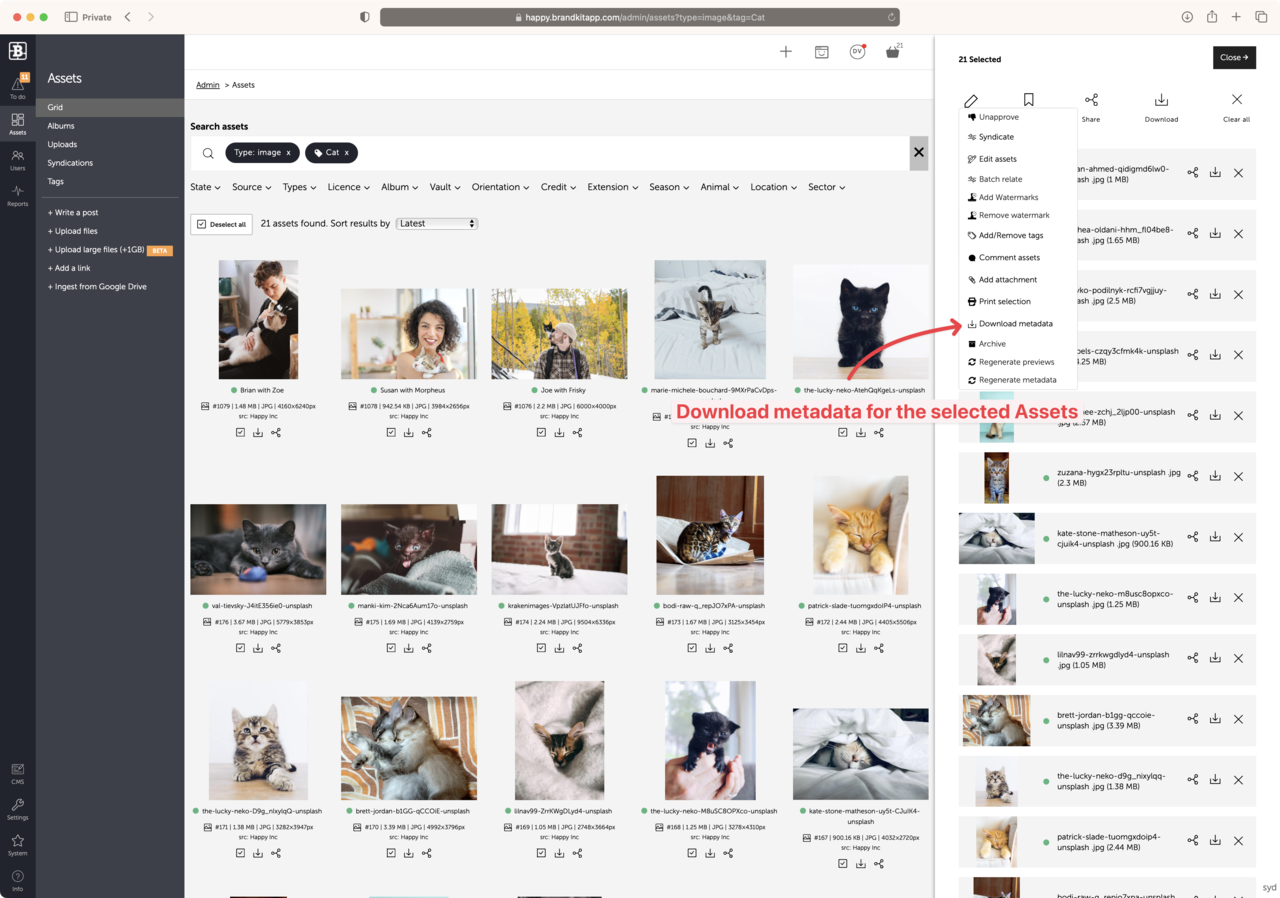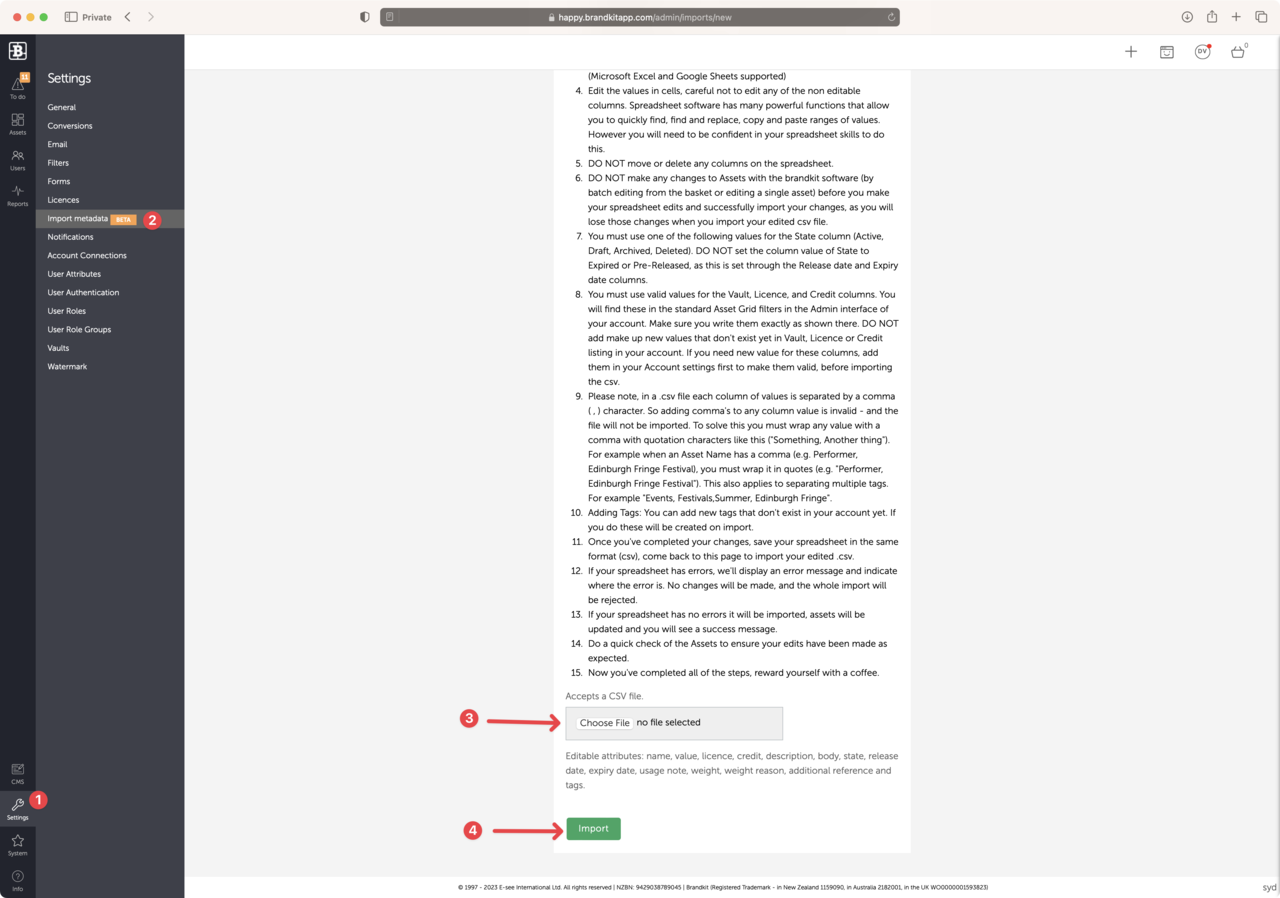How to update assets metadata by importing a metadata csv file

For Owner Users only.
Importing a .csv file of your metadata can speed up the organisation of your assets and allows you to make bulk edits to Asset metadata. This is an advanced feature that allows you to make bulk edits to Asset Metadata via Spreadsheet software (such as Microsoft Excel or Google Sheets).
Step 1 - Export your Asset metadata from Reports or from the Basket
- First Upload (or Create) all of your assets through the normal upload (+) button in Admin
- You can then downoad a csv file with a row per Asset. and metadata fields arranged in columns.
- You can export all metadata for all your current assets or just a few by using Search and Filters in the Report page.
- You can also export from the Basket, by searching and selecting Assets. Then from tge Basket Edit menu drop-down, select Export metadata
- You should refrain editing Assets in the Admin interface in the normal way, whilst editing the metadata, until you imported back your changes (Step 3 below), as you will lose any of those changes when you import the edited CSV..

- Navigate to Admin, then Reports
- Select the Asset metadata report
- Search for the Assets you want to export metadata for. Leave search blank to export all assets.
- Click the Download CSV button.
Expert Tip You can also export Asset metadata from the Basket, allowing you to download a csv for an explicit selection of Assets (as seen below)

Step 2 - Edit in Spreadsheet Software
Download the Asset Metadata you want to edit from Reports: Asset Metadata in your acount
Once you’ve downloaded the CSV file as in step 1 above, you should open in your preferred spreadsheet software. CSV files are an industry standard and you can edit in many applications, but we recommend and support Microsoft Excel and Google Sheets.
Once opened in either Excel or Sheets, you can use spreadsheet functions and formulae to manipulate values in column cells, provided you follow our instructions below. e.g. you can update entire columns of values by copy and pasting one value to all the other cells in the column. or use a Concatenate formula to append a column of values to the tags column, etc.
Please take care with the spreadsheet and note the following limitations:
- Do Not alter the column order.
- Do Not change column names.
- Do Not edit the values in the Asset ID, Original Filename, Asset Type or the File Extension columns.
- Do Not make any changes to Assets with the Brandkit software (by batch editing from the basket or editing a single asset) before you make your spreadsheet edits and successfully import your changes, as you will lose those changes when you import your edited csv file.
- You must use one of the following values for the State column (Active, Draft, Archived, Deleted). DO NOT set the column value of State to Expired or Pre-Released, as this is set through the Release date and Expiry date columns.
- You must use valid values for the Vault, Licence, and Credit columns. You will find these in the standard Asset Grid filters in the Admin interface of your account. Make sure you write them exactly as shown there. DO NOT add make up new values that don’t exist yet in Vault, Licence or Credit listing in your account. If you need new value for these columns, add them in your Account settings first to make them valid, before importing the csv.
- Wrap any text values that contain a comma (,) in double quotes (“”). In a .csv file each column of values is separated by a comma ( , ) character. So adding comma’s to any column value is invalid and the file will not be imported, unless it is escaped by wrapping the value in double quotes (“text,text”). For example, when an Asset Name has a comma (e.g. Performer, Edinburgh Fringe Festival), you must wrap it in quotes (e.g. “Performer, Edinburgh Fringe Festival”). The exception is the Tags column which expects a comma separated list in the column cell. However, if an individual Tag uses a comma (inside the Tag) it must be escaped using double quotes inside the tag list (e.g. Events,Festivals,Summer,”Performer,Edinburgh Fringe”,Comedian,Street Performer,etc).
- Adding New Tags: You can add new tags that don’t exist in your account yet. If you do these will be created on import.
- Check that all date columns are in the YYYY-MM-DD format. Excel has a habit of changing the date format of the date columns. You will have to reset the date format for the column to YYYY-MM-DD e.g 2025-01-25 before you save to CSV again.
Once you’ve completed your changes, save your spreadsheet in the same format (.csv).
How to Download a CSV from Microsoft Office/Excel
Please refer this Microsoft support article
Please note:
- When selecting the file type in the file type drop-down of the save dialogue, choose the CSV (MS-DOS) format.
- Note that downloading as a CSV from the free online version of Excel is not supported.
How to Download a CSV from Google Sheets
- Open the spreadsheet in Google Sheets.
- Click on the tab you want to save as CSV.
- Go to File > Download > Comma Separated Values (. csv).
Step 3 - Import your edited CSV
Please note that the importing metadata feature is restricted to Brandkit Support and Owner users (users with the Owner user role) at this time.

- Navigate to Admin > Settings.
- Select Import metadata.
- Read the warnings and notes. Check that your spreadsheet changes comply. Then scroll to the bottom and select your CSV file by clicking the Choose File button.
- Click the Import button.
The file will upload and update the relevant Assets. Do a quick check of the Assets to ensure your edits have been made as expected.
Notes:
- If your spreadsheet has errors, we’ll display an error message and indicate where the error is. No changes will be made, and the whole import will be rejected. In this case go back to your spreadsheet and find the error, edit, save a try again. This can take some time and be frustrating, particularly if your spreadsheet is large with hundreds or even thousands of rows. Be patient - you’ll get there eventually.
- If your spreadsheet has no errors, it will be imported, assets will be updated and you will see a success message.
Now that you’ve completed all of the steps, reward yourself with a coffee.
Happy days :)
